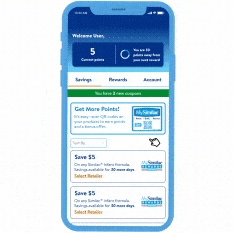Suggestions for successful cereal feeding:
- During the first few feedings, babies usually respond best to a thinner consistency.
- Put a small amount of warm cereal on the tip of a rubber-coated spoon and place it in your baby's mouth. Don’t be surprised if at first the food comes right back out. Their instinct is to use the same mouth and tongue movements as they did when nursing or sucking from a bottle.
- As your baby transitions from a totally liquid diet of breast milk or formula, they might not swallow much at first.
- As they get used to eating from a spoon, you can gradually increase the amount and consistency, offering 2 or 3 feedings a day.
Tips for introducing single-ingredient jarred foods to your baby
When introducing single-ingredient jarred baby foods, here are a few helpful hints to keep in mind:
- Introduce one new food at a time over the course of 3 to 5 days to watch for signs of food allergies. Speak with your pediatrician if there are concerns of food allergies present. You can learn more in our Food Allergies in Infants & Toddlers—Nothing to Sneeze At article, which provides information about food allergies.
- Start with a small amount of food and increase gradually—even a teaspoonful is enough for some beginners
- Do not feed your baby directly from the jar, as bacteria from their saliva will deteriorate the food
- Only feed your baby when they're sitting up
Stage 2: combination foods add variety to mealtime
Now that your baby is eating single-ingredient foods regularly, they will probably want to try a combination of foods for added variety and flavor. Stage 2 baby foods are made with 2 or more ingredients and might incorporate meat, grains, or legumes. They are roughly pureed or blended to be of a thicker consistency than stage 1.
You’ll know if they're ready for combination foods if they're about 6 months old and:
- Sit well without support
- Keep their head upright while sitting
- Eat a wide variety of single-ingredient foods
- Eat solid foods about 3 times a day
Remember that each baby’s food journey is different. The amount they eat will likely vary day-to-day.
Introducing combination foods to your baby
The first step is to always check the ingredients of any food you want to introduce. If your baby is sensitive to any single food, make sure it’s not a part of your food combinations, and:
- Introduce only one new ingredient at a time. Wait 3 to 5 days before introducing any other new foods to check for allergies.
- You can still keep single foods in your baby's diet. For example, you can feed them a favorite single-grain baby cereal from time to time for variety.
- During their first year, include breast milk or Similac® formula at each mealtime. It is a vital part of your baby's diet.
- Don’t worry if your baby refuses to eat solid foods, is fussy, or turns away. Try again later.
What if your baby seems to dislike some foods?
Your baby may make a face or literally turn their nose up at some foods you offer. This usually doesn’t mean they dislike the food. They’ll simply need time to adjust to this new taste on their tongue.
To help, use any new food as their first bite of solids for a few days. The first day, they might make a face and spit the food out. The second day, they may swallow the first bite, but might refuse the second. Patiently continue this pattern and they’ll most likely develop a taste for any new food, including strong-tasting veggies.
What if my baby has food sensitivity issues?
If your infant experienced food sensitivity issues and is on a sensitive formula such as Similac® 360 Total Care® Sensitive, you might be concerned about their transition to table foods. This may become more of an issue when they are approaching the end of their first year of life and transitioning to whole milk. Learn more about food sensitivities and allergies and the foods that are more likely to cause them in our Toddler Allergy article. As always, discuss any concerns you have about your baby's nutrition with their pediatrician.
Stage 3 baby food: nutrition by addition
Every baby is different; but, from about the age of 8 months, your baby should be ready for you to keep adding interesting new foods to their diet—foods with more complex tastes and textures. Almost anything goes at this stage, as long as the food is in small pieces and/or cooked until very soft to make it easy to chew.
Here are a few basic signs for knowing if your baby is ready for complex tastes:
- They can pull up from a sitting to a standing position
- They can walk by holding onto furniture
- They want to eat with their fingers
- They mash food well with their gums or teeth
- They enjoy a variety of tastes and textures
Start slowly and in stages to let your baby get used to the new tastes and textures of different kinds of finger and table foods. Patience and persistence are key! Continue to offer your baby fruits and/or vegetables at every meal, as well as at snack time. Keep this in mind for later, because the same principle applies to children who are 1 year and older!
As children are exposed to new foods, it's common to need to offer the new foods many times—around 10 times, in fact—before they'll accept them as familiar foods.
Noticing a yellow tinge to your baby's skin?
As you introduce colorful new foods to your little one’s diet, you may notice their skin taking on a yellow tinge. Check with your baby's healthcare professional, but usually this is a harmless and rare condition known as carotenoderma. As little as 2 tablespoons of pureed carrots every day for 5 to 7 weeks can cause a baby’s skin color to change in this way. It will usually go away if you stop feeding carotene-rich foods such as carrots, sweet potatoes, and peaches for a few days.
Feeding your baby solid foods: what are the DO's and DON’Ts?
It will still be months before they start talking, but your baby might be telling you things with their feeding signals. The following DO's and DON’Ts will help clue you in on baby’s mealtime needs and make the transition to solid foods as easy as possible for both of you.
When getting your baby started with solids…
DO remember that breast milk or Similac infant formula is still your baby's main source of nutrition for the first full year.
DON'T start solid foods earlier than about 6 months old, unless your baby's healthcare professional tells you otherwise.
DON'T offer foods that babies may choke on, such as uncut grapes or cherry tomatoes, raw carrots, celery, or nuts.
For mealtime success with your baby…
DO make sure your baby is hungry, but not overly so. A small "appetizer" of breast milk or Similac formula before feeding solids is recommended.
DO keep a sense of humor. Early feedings can be unproductive, challenging, and messy—but also funny and fun!
To recognize signs of hunger and fullness in your baby…
DO learn your baby's signals. Feed them when you see they eagerly swallow every bite, follow the spoon with their eyes, and become impatient for more.
DON'T continue feeding your baby if they turn their head away, refuse to open their mouth, or cry when you try feeding them.
To add new ingredients and foods…
DO wait 3 to 5 days to add each new food to your baby's diet so you can detect any allergic reaction your baby might have to a certain food.
DON'T season your baby’s food. Babies do not need added salt or sugar.
DO serve baby food from a small bowl. Feeding directly from a jar can encourage bacteria growth, and your baby's saliva can make the food watery.
DON'T put your baby to bed with a bottle. This can promote "baby-bottle mouth," a form of tooth decay.
DO gently stir and test the temperature of solid foods warmed in the microwave before serving. Make sure the temperature is warm, not hot.
DON'T feed cereals or other solid foods through a bottle, unless your healthcare professional directs you to do so. Cereal in a bottle might cause your baby to gag or choke, and it could increase how much food they eat, which may promote excessive weight gain.
DON'T feed your baby in a reclining position because of the danger of gagging or choking.
Baby & toddler nutrition recommendations
Infants
| Young Toddlers
| Older Toddlers
|
|---|
0-6 months
| 6-12 months
| 1-2 years
| 2-3 years
|
Breast milk
|
|
|
Infant formula
|
|
|
| Solid foods, such as iron-fortified baby cereal
| Solid foods, cow’s milk, water
|
|
| Toddler drinks (optional)
|







